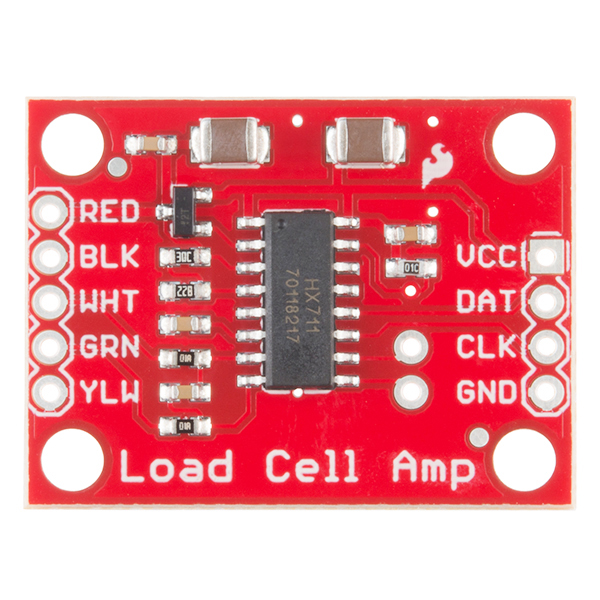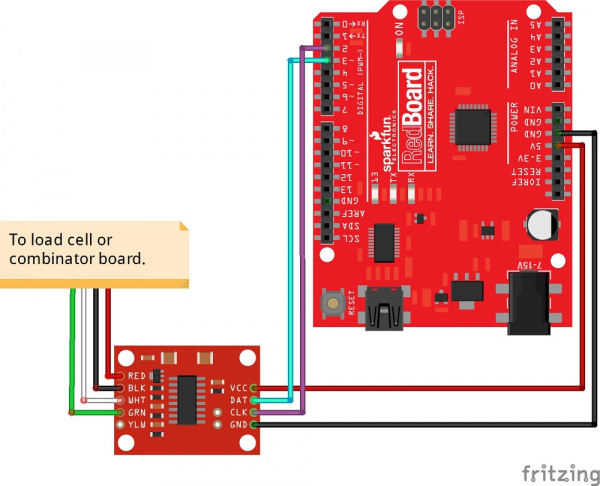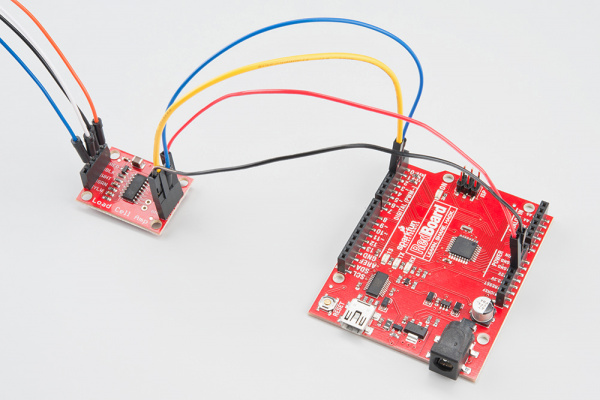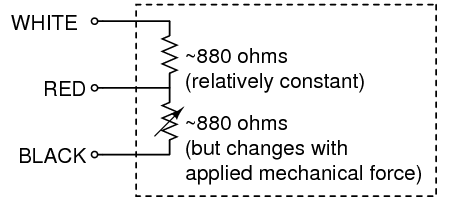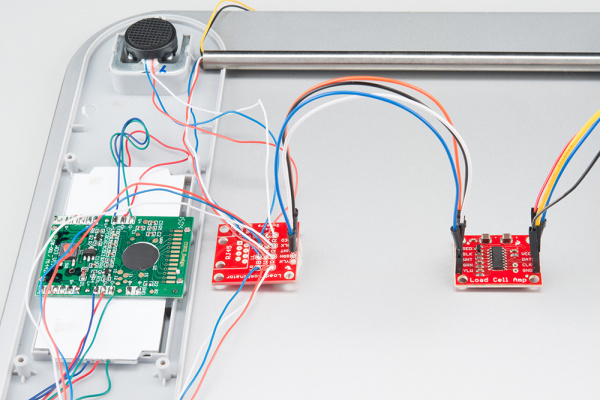RETIRED - Load Cell Amplifier HX711 Breakout Hookup Guide
This Tutorial is Retired!
This tutorial covers concepts or technologies that are no longer current. It's still here for you to read and enjoy, but may not be as useful as our newest tutorials.
View the updated tutorial: Load Cell Amplifier HX711 Breakout Hookup Guide
Hardware Hookup
The HX711 Load Cell Amplifier accepts five wires from the load cell. These pins are labeled with colors; RED, BLK, WHT, GRN, and YLW. These colors correspond to the conventional color coding of load cells, where red, black, green and white wires come from the strain gauge on the load cell and yellow is an optional ground wire that is not hooked up to the strain gauge but is there to ground any small outside EMI (electromagnetic interference). Sometimes instead of a yellow wire there is a larger black wire, foil, or loose wires to shield the signal wires to lessen EMI.
In General, each load cell has four strain gauges that are hooked up in a wheatstone bridge formation as shown above.
The four wires coming out from the wheatstone bridge on the load cell are usually:
- Excitation+ (E+) or VCC is red
- Excitation- (E-) or ground is black.
- Output+ (O+), Signal+ (S+)+ or Amplifier+ (A+) is white
- O-, S-, or A- is green or blue
Some load cells might have slight variations in color coding such as blue instead of green or yellow instead of black or white if there are only four wires (meaning no wire used as an EMI buffer). You might have to infer a little from the colors that you have, but in general you will usually see these colors.
Once the load cell is is hooked up to the amplifier, you can hook up VCC, DAT, CLK, and GND to a micro controller such as a RedBoard or Arduino board.
The example code has DAT and CLK **hooked up to **pin 3 and 2 respectively, but this is easily changed in the code. Any GPIO pin will work for either. Then VCC and GND just need to be hooked up to 2.7V-5V and ground respectively on your microcontroller.
Now, if you would like to set up four single strain gauge load cells with our combinator board and the amplifier, it works in a similar way, hooking up the red, black, and white wires from four different single strain gauge load cells and then hooking up the five RED, BLK, WHT, GRN, and YLW pins from the combinator board to the HX711.
The combinator board also has room for an 8 pin RJ45 socket, which can be used to connect your project via Ethernet cables for long distance applications.
Another nice thing about our combinator board is that most home scales use four single strain gauge load cells, so this is a handy board for hacking your own scales at home!
An off the shelf scale might be a little different. In the scale pictured above, the black wire was actually blue, the red more of an orange color, and the orange wire ended up being the 'center tap' of the strain gauge as opposed to white. I hooked the blue wires to the "B", the orange wires to the "W" and the white wires to the "R".
To determine how to hook up your single strain gauge load cells to the combinator, measure the resistance between the three wires. You should find a larger resistance (close to double) between a pair. In our example the resistance between White and Blue was 1.8k Ω, and the resistance between White and Red was 900 Ω. Therefore, the center tap to the strain gauge is the Red wire. The center tap or center pin of your strain gauge connects to the "W" pin on the combinator. The larger resistance wires (White and Blue in this example) connect to the "R" and "B" pins on the combinator.
The combinator board hooks up the four load sensors in such a way that two resistors in the wheatstone bridge configuration are constant values and the other two are variable in this way:
Once you have the combinator board successfully soldered to the twelve wires, you can now connect it to the HX711 amplifier board via the 4 standard load cell wires. You can use short jumper wires or if your electronics are a long distance away from your scale consider using an RJ45 connector and an ethernet cable to connect the combinator to the HX711 amplifier.
